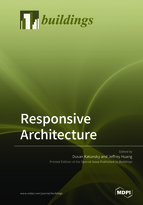Responsive Architecture
A special issue of Buildings (ISSN 2075-5309). This special issue belongs to the section "Building Energy, Physics, Environment, and Systems".
Deadline for manuscript submissions: closed (28 February 2019) | Viewed by 60956
Special Issue Editors
Interests: building physics; architectural engineering
Special Issues, Collections and Topics in MDPI journals
Special Issue Information
Dear Colleagues,
Similarity architecture or responsive architecture has been a well-known term for more than 50 years. Originating in the middle of the last century, it has many definitions.
The basis, however, is the creation of buildings or structural elements of buildings that are able to adapt to external influences, external conditions, and overall outdoor environments. A building and its elements utilize physical states and force effects (light, heat, humidity, noise) in the form of sun, wind, and rain. These effects are used to make the building elements or the building as a whole change and adapt sensitively to create a suitable (self-sustaining, self-adaptive) sustainable architecture, building, and environment. The shape of the building will be able to appropriately adapt to environmental conditions. External conditions also cause the adaptability of the construction elements to create a suitable internal environment.
The Special Issue of Buildings on “Responsive Architecture” will also be dedicated to sensitive, creative, adaptable, and sustainable architecture. This issue will deal with case studies and demonstrations of concrete (real) situations from practice. It will also deal with the design of adaptive structural elements, and the constructional justification of designing an adaptive architectural detail of a building. All ideas that support the suitability of adaptive designs are welcome.
Prof. Dušan Katunský
Prof. Jeffrey Huang
Guest Editors
Manuscript Submission Information
Manuscripts should be submitted online at www.mdpi.com by registering and logging in to this website. Once you are registered, click here to go to the submission form. Manuscripts can be submitted until the deadline. All submissions that pass pre-check are peer-reviewed. Accepted papers will be published continuously in the journal (as soon as accepted) and will be listed together on the special issue website. Research articles, review articles as well as short communications are invited. For planned papers, a title and short abstract (about 100 words) can be sent to the Editorial Office for announcement on this website.
Submitted manuscripts should not have been published previously, nor be under consideration for publication elsewhere (except conference proceedings papers). All manuscripts are thoroughly refereed through a single-blind peer-review process. A guide for authors and other relevant information for submission of manuscripts is available on the Instructions for Authors page. Buildings is an international peer-reviewed open access monthly journal published by MDPI.
Please visit the Instructions for Authors page before submitting a manuscript. The Article Processing Charge (APC) for publication in this open access journal is 2600 CHF (Swiss Francs). Submitted papers should be well formatted and use good English. Authors may use MDPI's English editing service prior to publication or during author revisions.
Keywords
- Responsive architecture
- Structure of building
- Adaptive detail
- Building design
- Creative design
- Sustainability in architecture







